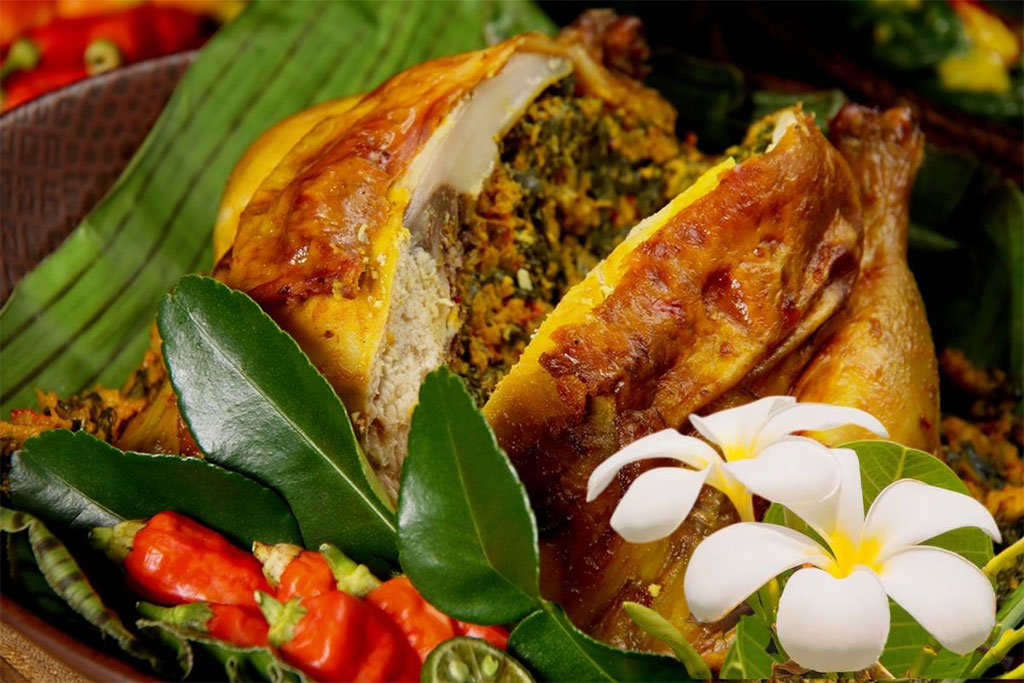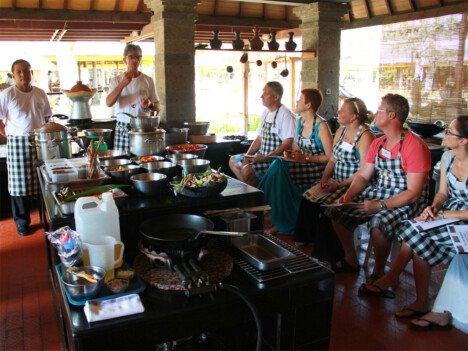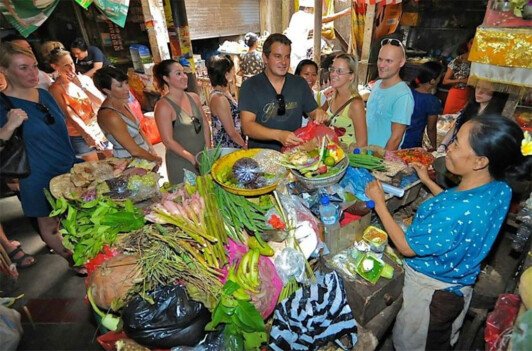Bali isn’t just famous for its breathtaking temples, sun‑kissed beaches, and lush rice terraces. Its vibrant cuisine is a soulful journey unto itself: a harmonious blend of savory, sweet, spicy, and aromatic that captures the heart with each bite. Whether you’re planning a trip or simply daydreaming of tropical flavors, these seven traditional Balinese dishes should top your hit‑list. Let’s dive into the island’s culinary treasures — prepare for a delicious journey!
1. 🐔 Ayam Betutu – Bali’s Regal Roast
The Essence
Ayam Betutu is a majestic masterpiece in Balinese cuisine — a whole chicken (or sometimes duck) marinated in bumbu betutu, an intricate spice blend of turmeric, ginger, garlic, galangal, chilies, shallots, candlenuts, coriander, and kaffir lime leaves. Wrapped in banana leaves and slow-cooked for hours, it emerges tender, aromatic, and deeply infused with Bali’s soul.
What Makes It Special
- Complex Spice Profile: Earthy, spicy, fragrant — betutu spice paste is culinary poetry.
- Cooking Ritual: Traditionally wrapped in banana leaves and buried in glowing embers, this slow-roasting method delivers melt‑in‑your‑mouth meat and intensely smoky undertones.
- Communal Dish: Often featured at weddings, temple ceremonies, and festive gatherings — it’s a symbol of celebration.
Where to Savor
In Ubud or Sidemen, upscale restaurants and warungs offer their spin — some roast it in clay ovens, others use bamboo tubes. For true authenticity, seek local warungs where the aroma crisps your senses as you approach.
2. 🍖 Babi Guling – The Legendary Suckling Pig
The Legend
If Bali had a national dish, Babi Guling (suckling pig) would be a serious contender. Roasted whole on spits, this pig is slathered with bumbu base genep — a rich paste of turmeric, garlic, shallots, galangal, coriander, lemongrass, black pepper, and chili. The result? Crisp crackling, succulent meat, and deeply spiced fat.
Highlights
- Crackling Magic: Think of chicharrón on steroids — irresistible, ultra-crunchy, smoky skin.
- Perfect Layering: Savory meat, aromatic fat, sticky rice, spicy sambal — every bite delivers a symphony.
- Cultural Staple: Central to ceremonies like weddings and temple anniversaries (odalan).
Where to Find It
In Denpasar’s bustling streets — warung Ibu Oka and Ibu Rai in Ubud are renowned. Jalan Teuku Umar in Denpasar is another hotspot; arrive early because when it’s gone, it’s gone!
3. 🥥 Sate Lilit – Reef to Skewer Delight
What It Is
Sate Lilit is Bali’s elegant twist on skewers. Instead of large meat chunks, finely minced fish (or sometimes chicken, pork, or even turtle) is combined with coconut, grated mild spices, and coconut cream, then tightly wound around lemongrass or bamboo sticks before grilling.
What Makes It Irresistible
- Coconut Creaminess: Rich yet light, with tender bites of seafood mixed with coconut’s sweetness.
- Fragrance of Lemongrass: The lemongrass stick cook imparts citrusy, fresh aroma that’s unforgettable.
- Street‑Food Charm: Easy to eat on the move, perfect after a beach swim or temple visit.
Recommended Spots
Kuta’s buzzing beachside stalls, Seminyak’s night-market enclaves, and Ubud’s traditional warungs all offer excellent versions. Night markets, such as Gianyar’s, are particularly magical.
4. 🍲 Lawar – Balinese Ritual Salad
What You Need to Know
Lawar is no ordinary salad — it’s a ritual dish, a vibrant medley of minced meat (pork, chicken, or sometimes rare bits of fresh pig blood), finely chopped coconut, aromatic herbs, galangal, turmeric, green beans, kaffir lime leaves, chilies, and a sprinkle of crispy pork cracklings (sisik babi).
Why It’s Addictive
- Multi‑Dimensional Textures: Tender meat, crunchy coconut, crisp veggies.
- Bold Flavors: Earthy, spicy, herbal, slightly gamey — every mouthful is terrain-rich.
- Communal Tradition: Served during temple ceremonies and festive events, where everyone shares from the communal platter.
Where to Taste
Warungs specializing in Balinese ceremonial cuisine — in Gianyar and local markets around Ubud or Bangli. Ask for lawar kampung for the most authentic, village-style version.
5. 🍜 Nasi Campur Bali – Smoky, Spicy, Supreme
A Bali Essential
Nasi Campur means “mixed rice,” and in Bali, it becomes a festival of flavors around your plate. Expect a scoop of steamed rice with small portions of:
- Slow-cooked meats (chicken, pork, duck)
- Babi guling or ayam betutu
- Steamed or stir-fried vegetables
- Sambal matah — a raw chili-lime shallot relish
- Crunchy tempeh and tofu
- Lawar, sate lilit, or other local specialties
Why You’ll Crave It
- Flavor Variety: One plate, many experiences — sweet, sour, spicy, savory.
- Flexible & Affordable: Customize to your hunger and budget in warungs.
- Cultural Snapshot: A miniature tour of Balinese cuisine in a single serving.
Where to Enjoy
Available everywhere — from roadside stalls to upscale cafes. Try Ubud’s Warung Nasi Pedas Ibu Andika for fiery renditions or Seminyak’s stylish cafés for scenic dining vibes.
6. 🌶️ Sambal Matah – The Zesty Heartbeat
Unpacking the Relish
Sambal Matah, from Bali’s eastern shores, is not a dish but the ultimate condiment — a fresh, uncooked relish made from finely chopped shallots, lemongrass, red chilies, garlic, kaffir lime zest, and coconut oil or seasoned oil. Serve it atop meats, fish, or rice — it transforms everything.
Irresistible Traits
- Bright & Fragrant: Its citrusy, herbal, spicy punch defines Balinese flavor.
- Customizable Heat: Spice level adjusts to your tolerance — mild to molten!
- Infectiously Addictive: You’ll scoop extra onto every plate.
Best Uses
Generous spoonfuls crown nasi campur, ikan bakar (grilled fish), and even international dishes on Bali menus. Many warungs serve it on the side — always add more!
7. 🍬 Dadar Gulung – Sweet, Green Coconut Pancake
A Sweet Finale
Dadar Gulung is a popular Balinese dessert — a soft green pancake flavored with pandan leaf, wrapped around a sweet filling of grated coconut and palm sugar cooked to gooey perfection.
Why It Slays
- Soft & Sweet: Silky sponge with chewy coconut and caramel sweetness.
- Vibrant Green: Natural pandan color makes it eye‑catching and Instagram‑ready!
- Portable Delight: Perfect for beach walks or a midday treat.
Where to Find It
Street vendors, local markets, and many warungs carry these — often perched next to packs of banana‑leaf snacks and sticky rice treats.
🔍 A Deep Dive into Flavors, Culture & Making
Spice Culture That Speaks
Balinese cooking is all about spice pastes called bumbu. Fresh ingredients like turmeric, galangal, lemongrass, candlenuts, kaffir lime leaves, chilies, garlic, and shallots are ground into pastes using a traditional mortar and pestle (ulekan). That pounding motion extracts bright, bold flavors unseen in processed alternatives. Every home cook has their unique paste, passed down generations.
Tradition, Ritual & Food
Balinese cuisine intertwines with Hindu spiritual life. Food is an offering to gods (canang sari), an expression of gratitude and harmony. Ceremonial feasting is communal — fresh prosperity literally feeds the soul. This ritual dimension gives each dish a sensory depth beyond taste.
Street to Haute Dining
A culinary tour of Bali might start at humble warungs or market stalls — fragrant smoke, sizzling pans, vibrant colors — then lead you to swanky bistros and seaside restaurants where chefs reimagine classics. Many places pay homage to ancestors, blending rustic ingredients with modern technique.
Insider Tips for Tourists
- Eat With Locals: Warungs serve authenticity. Look for places filled with locals.
- Ask About Spice Levels: Bali brings heat; if you’re not a chili fan, say “not pedas!”
- Pair With Local Rice Wine: Arak Bali adds spicy warmth and balances flavors.
- Take a Cooking Class: Get hands‑on with spice pastes and learn the secrets of the mortar.
🧭 Your Bali Culinary Adventure Itinerary
Day 1: Ubud’s Heart
- Morning: Dive into a Nasi Campur breakfast, savoring sambal matah, lawar, tempe.
- Afternoon: Street food tour, including sate lilit and Babi Guling.
- Evening: Sit-down dinner featuring Ayam Betutu alongside local wine.
Day 2: East Bali – Sidemen & Rice Fields
- Morning: Watch spice‑stone pounding at a local home.
- Lunch: Traditional Sideman warung, generous servings of spicy ayam and lawar.
- Sunset: Beach walk with Dadar Gulung from a vendor.
Day 3: Denpasar / Sanur Feast
- Brunch: Sampling various Lawar styles in Denpasar’s bustling market.
- Late Lunch: Order Babi Guling at a top warung — crispy crackling is mandatory.
- Night: Mangon the sambal matah‑rich ikan bakar — grilled fish — at a beachside shack.
🧠 Beyond the Plate: Exploring Culinary Connections
Regional Influence
While distinct from Java or Sumatra, Bali’s proximity and historical trade routes infused its cuisine with Indian, Chinese, and other Southeast Asian flavors — all anchored by fresh island-grown aromatics.
Balancing Flavors
Balinese food aims to strike perfect harmony — sweet, spicy, sour, salty, and umami. That’s why each plate feels complete — no condiment left behind.
Food as Celebration
If your timing aligns with village festivals (odalan), weddings, or the Temple anniversary, you might witness true Balinese culinary pageantry: food offerings (door in canang) and communal cooking to honor the gods and share prosperity.
👩🍳 Bring Bali Home: A Cooking Guide
Pantry Must‑Haves
- Fresh turmeric and galangal
- Candlenuts (or macadamias if unavailable)
- Kaffir lime leaves and zest
- Bird’s eye chilies
- Tamarind paste
- Pandan leaves (for sweets)
- Coconut oil or cream
Essential Tools
- Mortar & pestle (ulekan) — so important for traditional bumbu
- Banana leaves — for wrapping Ayam Betutu or Babi Guling
- Lemongrass stalks — both for flavor and skewers
Beginner Recipe Roadmap
- Sambal Matah: Chop shallots, chilies, lemongrass, garlic, lime; toss with coconut oil and salt.
- Dadar Gulung: Make a green pandan pancake, fill with coconut‑palm sugar mixture, fold.
- Ayam Betutu/Lawr: Try blending a small batch of spice paste, marinate chicken or pork, steam in banana leaf pouch, then crisp-grill.
🌿 Sustainability & Cultural Respect
- Choose Local & Seasonal: Bali offers abundant fresh produce — support local farmers and reduce footprint.
- Learn the Rituals: Food isn’t just fuel—it’s spiritual. Ask before photographing temples or offerings.
- Reduce Waste: Bring your own container for souvenirs; enjoy near-zero plastic warungs.
🎯 Final Takeaway
These seven traditional dishes — Ayam Betutu, Babi Guling, Sate Lilit, Lawar, Nasi Campur Bali, Sambal Matah, Dadar Gulung — form the vibrant soul of Balinese cuisine. They bring together fragrant spices, fresh ingredients, communal spirit, and deep cultural roots. Whether you explore warungs, night markets, or high-end restaurants, Bali’s flavors will surprise you, comfort you, and invite you to savor every moment.
So the next time you’re craving Bali, turn the aroma of coconut and lemongrass into your passport. Each dish is not just food — it’s a slice of Balinese heart and soul.









